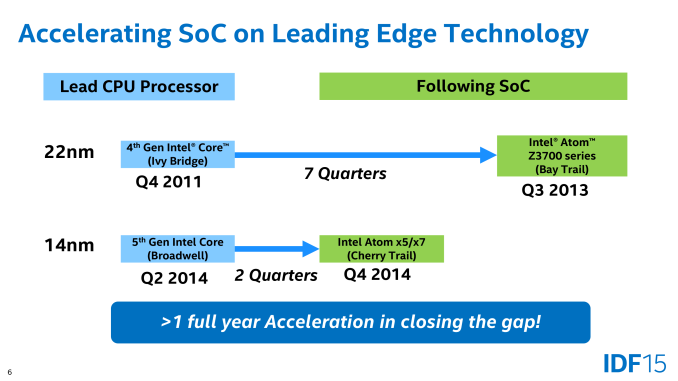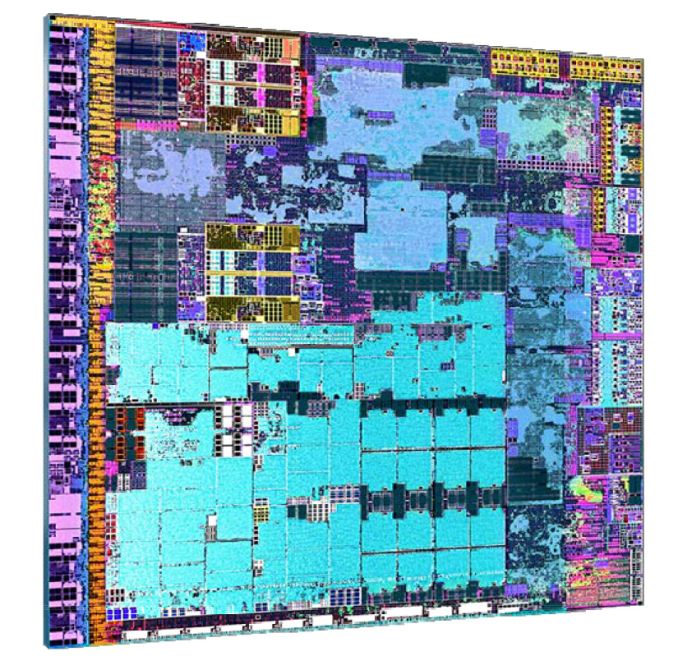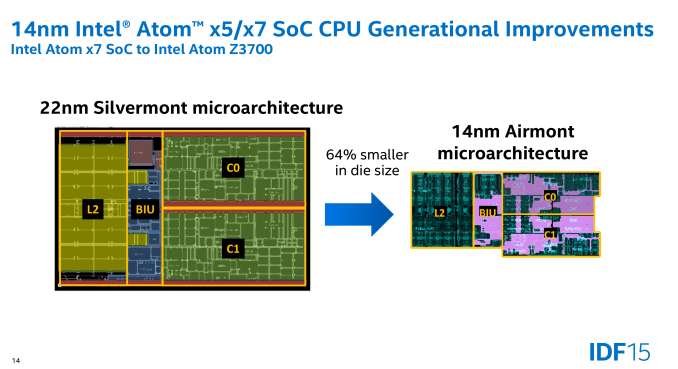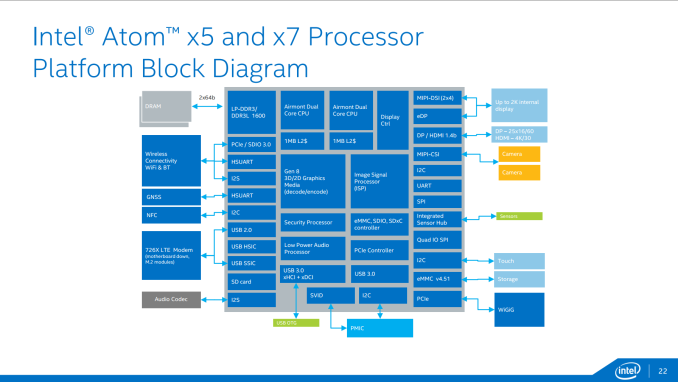The Surface 3 Review
by Brett Howse on May 4, 2015 9:00 AM ESTPowering the Surface 3: Intel’s Atom x7 System on a Chip
I still remember when back in 2011 Intel announced that they were finally going to stop treating Atom as a second class citizen at the manufacturing level, and bring it in line with the company’s mainstream Core processors. After having drawn out the 45nm and 32nm Atoms for too long, and suffering in the marketplace versus ARM as a result – Intel realized that to combat the growing threat of ARM they would need to treat the mobile market more seriously, and they would need to commit their sizable manufacturing advantage to the field to do this.
Now even Intel can’t turn on a dime – processors design begins half a decade in advance these days – so what have seen is a gradual ramping up towards this point. Silvermont, Intel’s first 22nm Atom, would introduce a more modern and better performing out-of-order architecture for Atom, meanwhile Intel would catch up on the manufacturing side by not producing 2 generations of Atoms on the 22nm node. Instead Silvermont would be the only 22nm Atom, and was to be followed by 14nm Airmont roughly a year later.
With Intel’s initial 14nm problems that year later ended up being a bit longer than a year, but in 2015 we’re finally there, and the change is remarkable. Only one generation ago, Intel launched their 22nm process as they always do, with desktop and high-performance laptop processors first. Now with 14nm the tables have been turned; Atom didn’t get first-dibs on 14nm – that went to Core M – but Airmont is still going to beat Intel’s desktop and high-performance Broadwell SKUs to the retail market. In one generation Intel has gone from favoring the desktop to favoring mobile, that’s how serious Intel has become.
That brings us to Surface 3, and the SoC powering it: Cherry Trail. The successor to the Silvermont-based Bay Trail that has powered so many x86 tablets in the last year, Cherry Trail is a distinct tick in Intel's tick-tock cadence. What this means is that Intel has largely retained the same architecture as in Bay Trail, investing in a fairly small number of updates, looking to take advantage of the power consumption and die size (cost) benefits of 14nm. To that end Intel has not even bothered to announce any major architectural changes for Airmont, and while there will likely be a few tweaks made to the CPU to make it work more efficiently on 14 nm, we will have to wait for Goldmont for the next big Atom architecture.
Cherry Trail itself is a fairly small chip. While Intel hasn’t released an official die size for it (no more than they did Bay Trail), from various IDF presentations they have released official numbers for the complete package, and decent photos as well. As a result we can take a decent stab at die sizes, and from Intel’s photos we’d estimate that the die size is around 83mm2. Unfortunately we don’t have anything quite comparable to Bay Trail, though we believe it to be a good bit smaller than Intel’s previous generation tablet SoC. At 83mm2 this would put the die size at quite a bit smaller than Apple’s A8X tablet SoC, and actually is just a hair smaller than the A8 phone SoC’s 89mm2.
Diving a bit deeper, Intel has also released some size data for individual Silvermont/Airmont CPU modules. The dual core modules, which contain the 2 CPU cores along with L2 cache and appropriate glue, have shrunk significantly from Silvermont to Airmont. Overall the Airmont CPU module is 64% smaller than the Silvermont module. And to be clear that does not mean Airmont is 64% of the size of Silvermont, that means that Airmont has been reduced by 64%; relative to Silvermont it is only 36% of the die size. Intel has achieved a better scaling factor than 22nm to 14nm alone, indicating that they have almost certainly enacted further optimizations to bring down the die size as an architectural level.
Moving on to the architecture of Cherry Trail, each Airmont core is a two-wide instruction decode with out of order execution. The L1 cache is 32 KB 8-way associative for instructions, and 24 KB 6-way associative data cache. Level 2 cache is 16-way associative with 1 MB of cache shared between two cores. There will be either two or four core versions available, which means that each SoC will have between 1 and 2 MB of L2 cache depending on the number of cores. There is no L3 cache on Atom.
The System on a Chip (SoC) has support for LP-DDR3 or DDR3L 1600 in dual-channel configuration, and has the blocks needed for PCIe 3.0, USB 2.0, USB 3.0, and support for up to three displays with eDP, DP, and HDMI 1.4b. The built in storage support is eMMC v4.5.1, which is typical for a tablet class processor.
Here is a Block Diagram of the SoC.
The one truely major change to the SoC is the inclusion of Intel's Gen 8 Graphics. Bay Trail used Gen 7 Graphics from Ivy Bridge, and Bay Trail only had 4 Execution Units (EUs) available. Cherry Trail ramps that up significantly, with the latest Gen 8 Graphics from Broadwell now onboard, bringing forward Intel's GPU enhancements over the last two half generations, not to mention the compute enhancements as well.
In terms of execution hardware the x7-8700 model has 16 EUs available, indicating that Intel has spent a significant amount of their die size savings from the 14nm process on graphics resources. Gen 8 has eight EUs per sub-slice but a minimum of three sub-slices in the design, and therefore in order to improve SoC yields the thread scheduler will dynamically allocate the right amount of cores per-subslice to total 16. For comparison, Intel's Broadwell line of Core processors have a minimum of 23 (but most have 24) EUs available, and a maximum of 48, so with Cherry Trail Intel has closed the top-to-top gap in execution resources between Core and Atom to just 3-1.
In Intel’s datasheets, the Atom GPU is labeled as Gen8-LP to designate that this is a low power model being used in a tablet. The base frequency for this GPU is 200 MHz, with a boost of 600 MHz.
In addition to the GPU update, the ISP and hardware decode capabilities get a bump as well. There is full hardware acceleration for decode of H.263, MPEG4, H.264, H.265 (HEVC), VP8, VP9, MVC, MPEG2, VC1, and JPEG, as well as hardware encode for H.264, H.263, VP8, MVC, and JPEG. This marks the first Intel product to ship with the company's full, fixed-function HEVC decoder, making Atom the company's most advanced media processor, at least for this short moment.
The overall SoC is 17mm x 17mm, and the Z-height is 0.937mm, so it is quite a bit smaller than Core M’s 30mm x 16.5mm x 1.05mm package. Intel is not listing a Thermal Design Power for the Atom chip, but is instead listing it as a Scenario Design Power of 2 watts. The CPU base frequency is 1.6 GHz with a turbo frequency of 2.4 GHz, and there is also support for a Low Frequency Mode of just 480 MHz for extra power savings when needed.
| Atom x7-8700 | Atom Z3785 | |
| Architecture | Cherry Trail (Airmont) | Bay Trail (Silvermont) |
| Cores / Threads | 4 / 4 | 4 / 4 |
| Base Frequency (MHz) | 1.6GHz | 1.5GHz |
| Turbo / Burst (MHz) | 2.4GHz | 2.4GHz |
| L2 Cache | 2 MB | 2 MB |
| SDP | 2 W | 2.2 W |
| GPU Architecture | Gen 8 | Gen 7 |
| GPU Execution Units | 16 | 4 |
| GPU Frequency / MHz | 200-600MHz | 313-833Mhz |
| DRAM | LPDDR3-1600 | LPDDR3-1333 |
So what we really have here is a massaged Bay Trail class chip, but the 14 nm process should allow for a higher period of sustained turbo frequencies to help out with performance. It will be interesting to see what Intel does with Goldmont, and if they will add things like hyper-threading or not, but that discussion is for another time.
















265 Comments
View All Comments
Luc K - Thursday, May 7, 2015 - link
Battery life of both Yoga 3 Pro and the Asus T300 Chi are not anywhere close to this one.Then again completely different kind of devices.
This Atom CherryTrail CPU is actually newer than Core M but different kind of line of CPU's obviously.
MattVincent - Tuesday, May 5, 2015 - link
The 64gb doesn't bother me but the 2gb of ram seems like its just cutting corners. Price goes up way to fast once you add on the accessories. They shouldn't be charging for the pen.TEAMSWITCHER - Tuesday, May 5, 2015 - link
Ya think? I just checked MacMall.com, and I can get a 2015 11" MacBook Air for $819. That includes an Intel Core i5 CPU with HD6000 graphics, a decent keyboard, industry leading trackpad, PCIe SSD, Thunderbolt port, 2 USB 3.0 ports, and MagSafe Power. The display on the Surface might be a little better, but the atom CPU and archaic storage are very more worse.I own an 2013 11" MacBook Air and have found it to be a very capable machine. The screen is small, but workable thanks to OS X's excellent full-screen app / virtual desktop implementation. When I'm in my office, I connect it to my 27" monitor, Apple Keyboard, & Magic Mouse and use it like any other desktop.
The Surface 3 possesses only one redeeming quality - a Pen. How bad are you willing to let Microsoft screw you over for a Pen? If the answer is "brutally" then buy a Surface 3.
xthetenth - Tuesday, May 5, 2015 - link
The screen isn't just small, it's wildly archaic with a low res and bad panel technology. I'd also love to see you try to use the air as a tablet. If you don't need a tablet, don't get a tablet, get an ultrabook.RafaelHerschel - Tuesday, May 5, 2015 - link
I considered a MacBook Air, but the screen was unacceptable at the price point. I'm sure that will be rectified in the future, but for now there are inexpensive Windows alternatives with much better screens.AnyOny24 - Wednesday, May 6, 2015 - link
If you want to talk about that price point you should talk about the Pro 3 core i5 which supports tablet mode / touch, the same pen you're talking about, bigger / better screen... silly comparison.damianrobertjones - Wednesday, May 6, 2015 - link
Or I can just buy the S3 along with a £20 BT keyboard.BlueBomberTurbo - Thursday, May 7, 2015 - link
Actually, the screen on the Surface 3 is the best portable screen you can get next to maybe the new Macbook. The Air's screen was terrible for anything requiring any level of color accuracy. You know, the artsy stuff that you can apparently only do on a Mac.The other redeeming qualities are its size and weight. I know I bought it specifically for those and the screen, as a portable workstation for my photography. When you cram lots of lenses and a couple camera bodies in your backpack, you're already hauling around a good amount of weight. A well-spec'd laptop certainly isn't going along for the ride, too.
lokhor - Tuesday, May 5, 2015 - link
Worst thing about the dock on the SP3 is that the angle cannot be adjusted so its virtually useless if you want to have it set up as a secondary screendigiguy - Tuesday, May 5, 2015 - link
Laughing out loud at the "bulky and heavy" comment. This tablet weights less than the ipad 4 and I was not hearing people call that bulky and heavy.... Better, this tablet has a whole inch more screen surface that the ipad.... But this is partly the fault of reviewers that call this a 10 inches device, like the ipad.... Why the ipad, that is 9.7 inches, is 10 inches and this one, at 10.8, is not 11 inches? Increase the screen size of the air and the weight will also go up, while still being a bit lighter, not to mention ipad 4 and below.I have a 600g 10.1 inches windows tablet and it feels very light and pleasant to hold with one hand, just awkward with its 16:9 ratio. The surface will feel more balanced.
Concerning storage speed, the 128GB model offers better performance (see this accurate review for more details http://www.notebookcheck.net/Microsoft-Surface-3-T...
Having said that, this is the performance with the encrypted SSD. Personally I decrypted the SDDs in all my tablets (Surface pro 3, HP Stream 8, etc.) and the performance, especially the sequential one, has significantly increased.